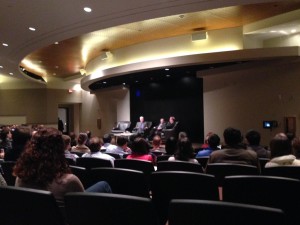By LAURA LOREK
Reporter with Silicon Hills News

Bob Metcalfe, professor of innovation at the University of Texas at Austin with Dr. Robert Langer, Koch Institute Professor at MIT.
Known as a modern-day Thomas Edison of biotechnology,
Dr. Robert Langer visited the University of Texas at Austin on Friday to inspire others who wish to emulate his success.
Langer gave UT students, faculty and guests advice on how he has started 18 companies, has written nearly 1,300 scientific research papers and received more than 1000 patents.
A Koch Institute Professor at MIT, Langer has conducted research in his lab that has led to drug discoveries resulting in billions of lives saved worldwide. He has also created more effective treatments for diseases such as cancer, diabetes, schizophrenia and alcoholism.
On the lighter side, through collaboration with Hollywood Actress Jennifer Aniston in a company called Living Proof, his chemical research has invented hair care products to add more body to dull and lifeless hair and to treat frizz.

Bob Metcalfe, Nicholas Peppas with UT and Robert Langer with MIT.
Langer shared some of his experiences in an hour-long discussion with Bob Metcalfe, Professor of Innovation at UT Austin and Nicholas Peppas, Chair of the UT Biomedical Engineering Department, during a talk to about 200 people at the AT&T Executive Education and Conference Center. He later gave another talk with Metcalfe and Dell Medical School Dean Dr. Clay Johnston on spurring innovation at the new UT medical school.
Peppas gave a lengthy introduction of Langer listing many of his accomplishments and awards. Langer has won more than 220 major awards including this year the Queen Elizabeth Prize for Engineering, one of the most influential engineering prizes in the world. Peppas concluded with the quick assessment of Langer as a man who solves problems and helps others solve problems too.
Next, Peppas asked Langer: “How do you do it?”
“Now it almost seems kind of natural,” Langer said.
Langer’s Lab at MIT focuses on biotechnology and materials science. His major interest is in drug development and delivery. In the lab, his students do thesis and postdoctoral projects and experiments that often lead to breakthrough patents and products. Langer wanted to get those discoveries out of lab and into the marketplace.
For a time, he thought that if they did the work, people would use it.
“It happens some of the time, but very rarely,” Langer said. “I found that if you’re not your own champion very few people use it.”
That really was the initial motivation for Langer to spin startup companies out of his lab.
“Some of it goes back to the early ‘80s,” Langer said.
The companies could do things Langer said he and his students couldn’t like manufacturing, clinical trials and create products that get out into the world.
“These companies magnified the impact of what we were doing in the lab tremendously,” Langer said.
But the process to commercialize technology was very hard.
The Patent Process
For one thing, Langer couldn’t get a patent issued. The patent examiner turned down his patent application five years in a row and the lawyer he was working with wanted to quit pursuing it because it was costing a lot of money. He finally convinced the patent examiner to allow the patent “on polymer systems for controlled release of macromolecules” after he provided affidavits from scientific experts that the work his lab was doing was against conventional wisdom.
“Having that patent was important,” Langer said.
But it was still painstakingly difficult to get a product to market. Multi-billion dollar companies licensed his patents. But the companies would do an experiment or two a year and when the experiments failed, they gave up, Langer said. That’s when he decided to start a company and he was able to get the patents back.
“It took a long time.” Langer said. “And even then when we did it we ran into problems. Our first CEO wasn’t very good. There were all kinds of issues. You keep learning, mostly by making mistakes.”
Working with Venture Capitalists
Metcalfe recounted the first time he first met Langer at Polaris Partners, a venture capital firm based in Boston. Metcalfe, a rookie venture capitalist, was just learning the ropes.
“That first week on the job, Terry McGuire (co-founder of Polaris) invited me to a meeting with you,” Metcalfe said.
Langer presented five PowerPoint slides on sugar sequencing tools and he was seeking a $1 million investment. At the end of the meeting, McGuire gave Langer the $1 million and Metcalfe kicked $100,000 in the deal.
Polaris and Metcalfe got a handsome return on that investment, Langer said.
The story of Momenta and creating the first bio-generic drug approved by the FDA
“Momenta is a good example of the kind of things we do,” Langer said.
No one had ever sequenced a polysaccharide, which is a complex chain of carbohydrates, until Momenta, a startup Langer co-founded, tackled the problem.
“We came up with a combination of technologies using enzymes and mass spectrometry that allowed us to sequence polysaccharides,” Langer said.
Momenta focused on creating generic versions of complex drugs, in particular, the researchers created Enoxaparin, a generic version of the $4 billion drug Lovenox, which is used to prevent blood clots.
“They didn’t think we could sequence it,” Langer said. “But we did. What happened is that led to making what’s called a bio-generic. The FDA allowed the approval of this. We could show a chemical identity with the techniques we had – so the FDA gave us the approval in 2010.”
Momenta’s generic version of Lovenox made more than $1 billion in its first year, Langer said.
But Langer’s work isn’t just about making money, it’s about saving lives.
In 2008, Langer worked with the FDA during the Chinese heparin crisis. Heparin, a widely used blood thinner, became contaminated and led to the deaths of people in 11 countries, Langer said. Momenta worked with the FDA and the Centers for Disease Control to identify the contaminate and to establish new standards by which heparin could no longer kill people, Langer said.
“The deaths went to zero,” Langer said. “That would never have happened without these sequencing technologies.”
Taking products out of the lab and to market
Peppas asked Langer how he comes up with his breakthrough ideas and when does he know it’s time to commercialize them.
Fundamental research in his lab or with a collaborator has sparked almost all of the companies, Langer said.
“We’re always doing the next project,” Langer said. “We’ve been working on a number of things for many years. Something reaches a point of maturity and makes sense to have a company.”
Timing is crucial when launching a company out of the lab.
“Sometimes people start too early or too late,” Langer said. “If you start too soon, investors get tired.”
He advised students and researchers to file a patent before they publish their paper in a scientific journal.
“An early draft of a paper for me is a good time to file a provisional patent,” he said.
Peppas asked Langer when should inventors approach investors?
“What I like do, if it’s possible, is go in with a bang,” Langer said. “Have a really powerful paper in Nature or Science. Know that we filed the patent and that we have good data. Go in before that paper is out.”
The story of Living Proof
 Metcalfe asked Langer how he got involved with creating Living Proof, his hair care company in collaboration with the Actress Aniston. He recalled Amir Nashat, a managing partner at Polaris, walking into a meeting and his jet black hair was shiny and beautiful and he was promoting Living Proof’s new hair care line.
Metcalfe asked Langer how he got involved with creating Living Proof, his hair care company in collaboration with the Actress Aniston. He recalled Amir Nashat, a managing partner at Polaris, walking into a meeting and his jet black hair was shiny and beautiful and he was promoting Living Proof’s new hair care line.
“Amir was one of my graduate students,” Langer said. “He got his PhD with me. But he ended up choosing a career in venture capital at Polaris.”
“Most of my research has been kind of basic engineering and science, if anything, applied to medicine,” Langer said.
One day, Nashat and John Flint, a partner at Polaris, visited him and asked him to tackle the problem of frizzy hair.
The science on hair wasn’t very good, Langer said. Out of the 50 products on the market to treat frizzy hair, all of them had silicone as their active ingredient, he said.
Researchers in Langer’s Lab took a material science approach to the problem. They wanted to find a material more hydrophobic than silicone to keep the moisture out. They discovered PolyfluoroEster and used it to create no-frizz shampoos and conditioners, which are one of Living Proof’s best-selling products at Sephora Stores. They also used fundamental chemistry and tapped into a library of polymers they had created to find polymers that could create more body for the hair, Langer said.
“It’s been quite exciting,” Langer said. “It’s been an interesting application of science to hair care.”
Langer also said he invests his own money in companies, but not that much. He usually does it to boost investment in a company he likes, because others follow his lead.
And although Langer has had a lot of failures in the lab, none of the companies he has started have failed.
Metcalfe asked Langer how he measures success?
“To me, the metric is helping people,” Langer said. “If you do that, and you make an impact, everything else flows.”

